Mexican and American actress Dolores del Río (1905–1983) was a Hollywood star in the 1920s and 1930s, and one of the most important female actresses of the Golden Age of Mexican cinema in the 1940s and 1950s. Del Río was the first major Latin cross-over star in Hollywood, and was considered one of the most beautiful faces that have emerged in the Hollywood cinema. She also appeared in several European films.
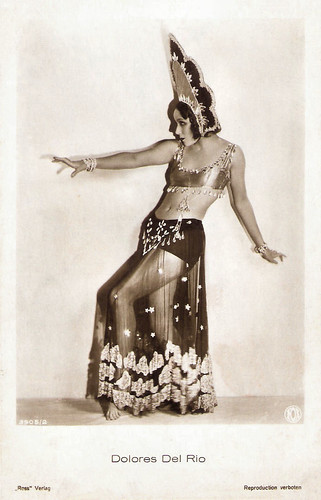
German postcard by Ross Verlag, no. 3905/2, 1928-1929. Photo: Fox. Publicity still for The Red Dance (Raoul Walsh, 1928). Del Rio is wearing a kokoshnik (Russian: коко́шник), a traditional Russian head-dress worn by women and girls.

German postcard by Ross Verlag, no. 3905/3, 1928-1929. Photo: Fox. Publicity still for The Red Dance (Raoul Walsh, 1928).
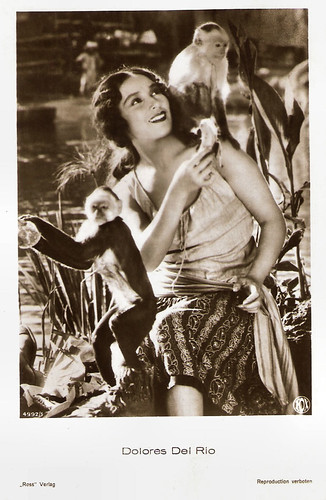
German postcard by Ross Verlag, no. 4993/1, 1929-1930. Photo: Fox.

German postcard by Ross Verlag, no. 5005/1, 1930-1931. Photo: Fox. Publicity still for The Trail of '98 (Clarence Brown, 1928).
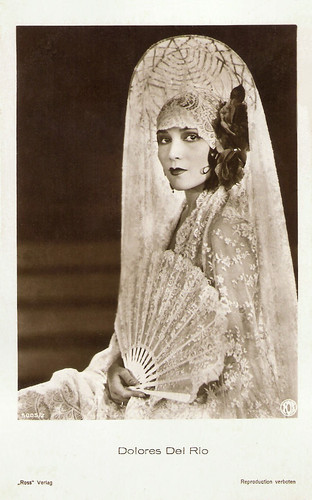
German postcard by Ross Verlag, no. 5005/2, 1930-1931. Photo: Fox. Publicity still for The Trail of '98 (Clarence Brown, 1928).
Dolores del Río was born Maria de los Dolores Asunsolo Lopez-Negrete in 1905 in Durango, Mexico. She was the daughter of Jesus Leonardo Asunsolo Jacques, who worked as a bank director, and Antonia Lopez-Negrete. They were members of the high class until the Mexican Revolution when they lost all their assets.
It was around this time that Dolores began dreaming of becoming an actress. On her mother's side, Dolores was a cousin of the Mexican filmmaker Julio Bracho and the Mexican actors Ramón Novarro and Andrea Palma. Besides acting, she also enjoyed dancing, especially ballet. While studying dancing, she would earn money by dancing for the rich families of the Mexican aristocracy.
A few years later, Dolores moved to Mexico City where she was discovered by director Edwin Carewe. He was so entranced by her that he became her agent, manager, producer and director. In 1925, she made her debut in the film Joanna (Edwin Carewe, 1925), starring Dorothy Mackaill. Because of her exotic looks, she was cast in a vamp role. Unfortunately, her part in the film was only about 5 minutes long and she was billed as Dorothy Del Rio in the credits. Carewe reassured her that the little that she appeared in the film looked extremely good and the public became interested in her.
Her second film was High Steppers (Edwin Carewe, 1926), starring Mary Astor and Del Río taking the second female credit. Carewe began promoting her as 'the female Valentino'. In the comedy Pals First (Edwin Carewe, 1926), he gave Del Río her first starring role. The films were not blockbusters, but helped to increase Del Río's popularity. Then, she was named a WAMPAS Baby Star along with Joan Crawford, Mary Astor, Fay Wray and Janet Gaynor, and Del Rio appeared in the hit film What Price Glory? (Raoul Walsh, 1926).
In 1927, Dolores was cast in the film The Loves of Carmen (Raoul Walsh, 1927). The first version, made 10 years earlier, had starred Theda Bara in the title role, but director Raoul Walsh decided to try it with a leading lady who was actually of Latin descent. Her background in dance certainly added to her convincing portrayal. Another box office hit was Resurrection (Edwin Carewe, 1927).
The following year, she had another career boost. United Artists signed Dolores up and she appeared in the film Ramona (Edwin Carewe, 1928), and also recorded the theme song. The film did have a synchronized score, but it was not considered a talkie. The theme song was heard on the radio with great strength both in the United States and Europe, and helped to increase the enormous success of the film. Del Rio made an extensive promotional tour in Euopa.
In March of 1928, the studio asked her over to Mary Pickford's home along with other big names so that they could speak on a radio show and give the audiences a taste of what they sounded like. Dolores ended up singing, which was a great treat for everyone. United Artists was getting a little fed up with the partnership between Dolores and Edwin Carewe. They felt that he used her as a stepping stone and they wanted to be in charge of her career. UA finally convinced Dolores to cut ties with the famed director which took a great weight off her shoulders. Carewe demanded that she pay him a huge amount of money to compensate for his losses and he cast one of Dolores's main rivals, Lupe Velez in his newest picture.
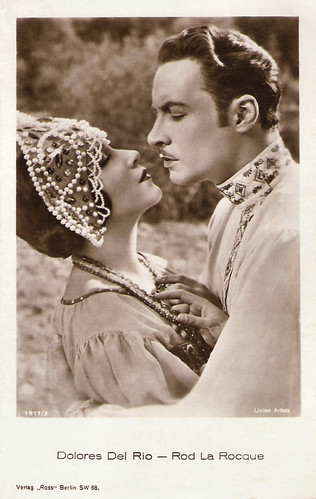
German postcard by Ross Verlag, no. 1917/3, 1927-1928. Photo: United Artists. Publicity still for Resurrection (Edwin Carewe, 1927) with Rod La Rocque.
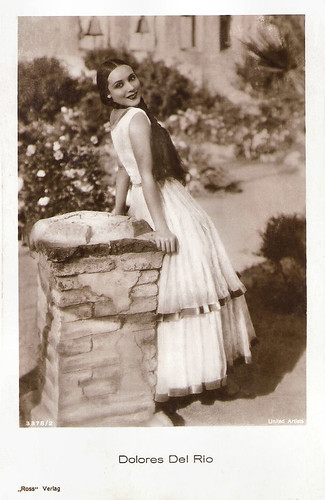
German postcard by Ross Verlag, no. 3378/2, 1928-1929. Photo: United Artists. Publicity still for Ramona (Edwin Carewe, 1928).
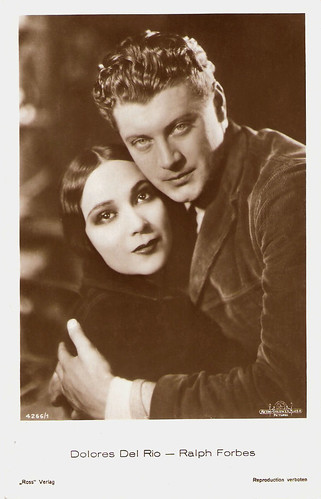
German postcard by Ross Verlag, no. 4266/1, 1929-1930. Photo: Metro-Goldwyn-Mayer. Publicity still for The Trail of '98 (Clarence Brown, 1928) with Ralph Forbes.
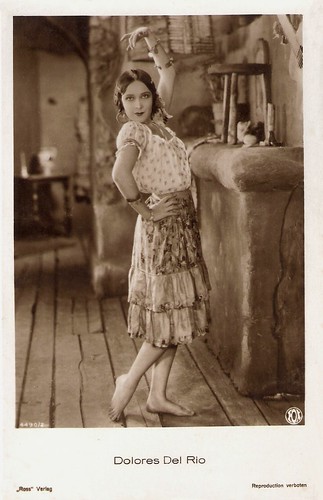
German postcard by Ross Verlag, no. 4490/2, 1929-1930. Photo: Fox. Publicity still for The Loves of Carmen (Raoul Walsh, 1927).
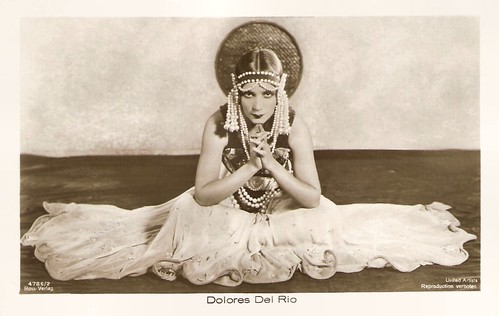
German postcard by Ross Verlag, no. 4786/2, 1929-1930. Photo: United Artists.
Dolores del Río continued focusing on her own career. In 1930, she appeared in the film The Bad One, with Edmund Lowe and Boris Karloff. Successful was also Bird of Paradise (King Vidor, 1932). She made the transition from 'an exotic star across the border' to one of the great Hollywood princesses. She appeared in Flying Down to Rio (Thornton Freeland, 1933) alongside Fred Astaire and Ginger Rogers in their first pairing.
Then she starred in Madame DuBarry (William Dieterle, 1934), but the film had the misfortune or being torn apart by the Hays office. It was edited so much that it came out almost nothing like the original story. The audiences didn't like it, and neither did the people involved in the making of the film.
As the 1930s progressed, her box office appeal began to wain. The heads of the studios preferred leading ladies like Joan Crawford and Norma Shearer, not Latina actresses. After making Journey into Fear (Norman Foster, 1942) with Orson Welles as producer, she moved back to Mexico
In Mexico, the film industry was at that time at its peak. There she received another career boost and made some of her most important films. These films like Flor silvestre/Wild Flower (Emilio 'El Indio' Fernández, 1943), María Candelaria (Emilio Fernández, 1943) with Pedro Armendariz, Las Abandonadas/The Abandoned (Emilio Fernández, 1944), Bugambilia/Secret Love (Emilio Fernández, 1944), La Otra/The Other One (Roberto Gavaldón, 1946) and La Malquerida/The unloved (Emilio Fernández, 1949), are now considered classic masterpieces and they helped boost Mexican cinema worldwide. María Candelaria (Emilio Fernández, 1943) was the first Mexican film to be screened at the Cannes International Film Festival where it won the Grand Prix becoming the first Latin American film to do so. The film was a great success in Europe and allowed Del Río to keep her international prestige.
In 1934, Del Río, along with other Mexican film stars of Hollywood like Ramón Novarro and Lupe Vélez, was accused of promoting Communism in California. This happened after the stars attended a special screening of the Sergei Eisenstein's film ¡Que viva México! (Grigori Aleksandrov, Sergei M. Eisenstein, 1932). Twenty years later, this would have consequences for her career. In 1954, Del Río was slated to appear in the 20th Century Fox film Broken Lance (Edward Dmytryk, 1954). The US government denied her permission to work in the United States, accusing her of being sympathetic to international communism. So she stayed in Mexico making films and with the decline of the Mexican cinema she opted for work in theatre.
In 1960 she returned to Hollywood and played opposite Elvis Presley in Flaming Star (Don Siegel, 1960). Elvis greeted her with flowers and said he knew exactly who she was and said it was an honour to work with her. Dolores soon began to look at him as a son and was very affectionate with him. She also appeared in Cheyenne Autumn (John Ford, 1964) and in European films like La dama del alba/The Lady of the Dawn (Francisco Rovira Beleta, 1966) and C'era una volta/Cinderella: Italian Style (Francesco Rosi, 1967) with Sophia Loren. Her final film role was as a grandmother opposite Anthony Quinn in The Children of Sanchez (Hal Bartlett, 1978).
Dolores del Río passed away in 1973 from liver disease in Newport Beach, California. Dolores Del Rio was married three times. Her first husband was Jaime Martinez del Río, the son of a wealthy Mexican family. She was only 16 years old when they met and was 18 years younger than him. Her second marriage was to MGM art director and production designer Cedric Gibbons from 1930 until 1940. Their divorce was caused by her affair with Orson Welles. The affair with Welles lasted two years and was very intense. He later called her the great love of his life. Her third and final marriage was to Lewis Riley, an American businessman. They married in 1959 and remained married until her death in 1983.

German postcard by Ross Verlag, no. 3660/3, 1928-1929 Photo: United Artists.
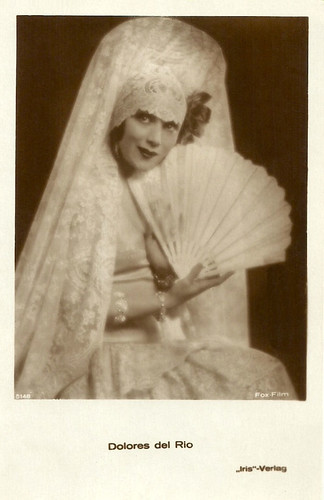
Austrian postcard by Iris Verlag, no. 5148. Photo: Fox Film. Publicity still for The Trail of '98 (Clarence Brown, 1928).
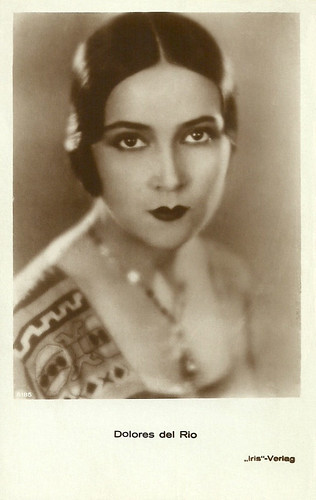
Austrian postcard by Iris Verlag, no. 5185.

Austrian postcard by Iris-Verlag, no. 5953. Photo: United Artists / Dr. Hauser u. Co. Publicity still for Revenge (Edwin Carewe, 1928) with James Marcus.
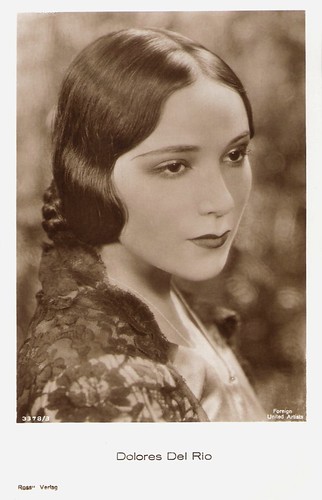
German postcard by Ross Verlag, no. 4786/2, 1929-1930. Photo: United Artists.
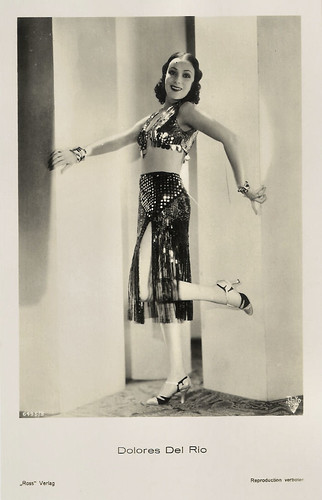
German postcard by Ross Verlag, no. 6495/3, 1931-1932. Photo: Radio Pictures.
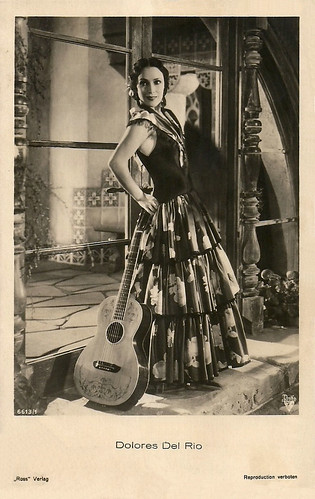
German postcard by Ross Verlag, no. 6613/1, 1931-1932. Photo: RKO.
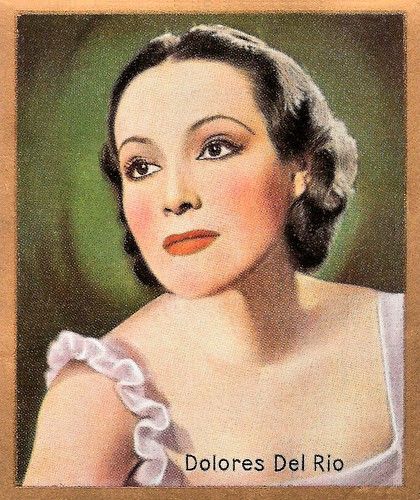
German cigarette card in the series Unsere Bunten Filmbilder by Ross Verlag for Cigarettenfabrik Josetti, Berlin, no. 232. Photo: Radio Pict. Corp.
Source: Jessica Keaton (Silence is Platinum), Wikipedia and IMDb.
For now, this was the last post in our series Imported from the USA. Next week starts a new series of film specials.

German postcard by Ross Verlag, no. 3905/2, 1928-1929. Photo: Fox. Publicity still for The Red Dance (Raoul Walsh, 1928). Del Rio is wearing a kokoshnik (Russian: коко́шник), a traditional Russian head-dress worn by women and girls.

German postcard by Ross Verlag, no. 3905/3, 1928-1929. Photo: Fox. Publicity still for The Red Dance (Raoul Walsh, 1928).

German postcard by Ross Verlag, no. 4993/1, 1929-1930. Photo: Fox.

German postcard by Ross Verlag, no. 5005/1, 1930-1931. Photo: Fox. Publicity still for The Trail of '98 (Clarence Brown, 1928).

German postcard by Ross Verlag, no. 5005/2, 1930-1931. Photo: Fox. Publicity still for The Trail of '98 (Clarence Brown, 1928).
The Female Valentino
Dolores del Río was born Maria de los Dolores Asunsolo Lopez-Negrete in 1905 in Durango, Mexico. She was the daughter of Jesus Leonardo Asunsolo Jacques, who worked as a bank director, and Antonia Lopez-Negrete. They were members of the high class until the Mexican Revolution when they lost all their assets.
It was around this time that Dolores began dreaming of becoming an actress. On her mother's side, Dolores was a cousin of the Mexican filmmaker Julio Bracho and the Mexican actors Ramón Novarro and Andrea Palma. Besides acting, she also enjoyed dancing, especially ballet. While studying dancing, she would earn money by dancing for the rich families of the Mexican aristocracy.
A few years later, Dolores moved to Mexico City where she was discovered by director Edwin Carewe. He was so entranced by her that he became her agent, manager, producer and director. In 1925, she made her debut in the film Joanna (Edwin Carewe, 1925), starring Dorothy Mackaill. Because of her exotic looks, she was cast in a vamp role. Unfortunately, her part in the film was only about 5 minutes long and she was billed as Dorothy Del Rio in the credits. Carewe reassured her that the little that she appeared in the film looked extremely good and the public became interested in her.
Her second film was High Steppers (Edwin Carewe, 1926), starring Mary Astor and Del Río taking the second female credit. Carewe began promoting her as 'the female Valentino'. In the comedy Pals First (Edwin Carewe, 1926), he gave Del Río her first starring role. The films were not blockbusters, but helped to increase Del Río's popularity. Then, she was named a WAMPAS Baby Star along with Joan Crawford, Mary Astor, Fay Wray and Janet Gaynor, and Del Rio appeared in the hit film What Price Glory? (Raoul Walsh, 1926).
In 1927, Dolores was cast in the film The Loves of Carmen (Raoul Walsh, 1927). The first version, made 10 years earlier, had starred Theda Bara in the title role, but director Raoul Walsh decided to try it with a leading lady who was actually of Latin descent. Her background in dance certainly added to her convincing portrayal. Another box office hit was Resurrection (Edwin Carewe, 1927).
The following year, she had another career boost. United Artists signed Dolores up and she appeared in the film Ramona (Edwin Carewe, 1928), and also recorded the theme song. The film did have a synchronized score, but it was not considered a talkie. The theme song was heard on the radio with great strength both in the United States and Europe, and helped to increase the enormous success of the film. Del Rio made an extensive promotional tour in Euopa.
In March of 1928, the studio asked her over to Mary Pickford's home along with other big names so that they could speak on a radio show and give the audiences a taste of what they sounded like. Dolores ended up singing, which was a great treat for everyone. United Artists was getting a little fed up with the partnership between Dolores and Edwin Carewe. They felt that he used her as a stepping stone and they wanted to be in charge of her career. UA finally convinced Dolores to cut ties with the famed director which took a great weight off her shoulders. Carewe demanded that she pay him a huge amount of money to compensate for his losses and he cast one of Dolores's main rivals, Lupe Velez in his newest picture.

German postcard by Ross Verlag, no. 1917/3, 1927-1928. Photo: United Artists. Publicity still for Resurrection (Edwin Carewe, 1927) with Rod La Rocque.

German postcard by Ross Verlag, no. 3378/2, 1928-1929. Photo: United Artists. Publicity still for Ramona (Edwin Carewe, 1928).

German postcard by Ross Verlag, no. 4266/1, 1929-1930. Photo: Metro-Goldwyn-Mayer. Publicity still for The Trail of '98 (Clarence Brown, 1928) with Ralph Forbes.

German postcard by Ross Verlag, no. 4490/2, 1929-1930. Photo: Fox. Publicity still for The Loves of Carmen (Raoul Walsh, 1927).

German postcard by Ross Verlag, no. 4786/2, 1929-1930. Photo: United Artists.
Great Hollywood Princess
Dolores del Río continued focusing on her own career. In 1930, she appeared in the film The Bad One, with Edmund Lowe and Boris Karloff. Successful was also Bird of Paradise (King Vidor, 1932). She made the transition from 'an exotic star across the border' to one of the great Hollywood princesses. She appeared in Flying Down to Rio (Thornton Freeland, 1933) alongside Fred Astaire and Ginger Rogers in their first pairing.
Then she starred in Madame DuBarry (William Dieterle, 1934), but the film had the misfortune or being torn apart by the Hays office. It was edited so much that it came out almost nothing like the original story. The audiences didn't like it, and neither did the people involved in the making of the film.
As the 1930s progressed, her box office appeal began to wain. The heads of the studios preferred leading ladies like Joan Crawford and Norma Shearer, not Latina actresses. After making Journey into Fear (Norman Foster, 1942) with Orson Welles as producer, she moved back to Mexico
In Mexico, the film industry was at that time at its peak. There she received another career boost and made some of her most important films. These films like Flor silvestre/Wild Flower (Emilio 'El Indio' Fernández, 1943), María Candelaria (Emilio Fernández, 1943) with Pedro Armendariz, Las Abandonadas/The Abandoned (Emilio Fernández, 1944), Bugambilia/Secret Love (Emilio Fernández, 1944), La Otra/The Other One (Roberto Gavaldón, 1946) and La Malquerida/The unloved (Emilio Fernández, 1949), are now considered classic masterpieces and they helped boost Mexican cinema worldwide. María Candelaria (Emilio Fernández, 1943) was the first Mexican film to be screened at the Cannes International Film Festival where it won the Grand Prix becoming the first Latin American film to do so. The film was a great success in Europe and allowed Del Río to keep her international prestige.
In 1934, Del Río, along with other Mexican film stars of Hollywood like Ramón Novarro and Lupe Vélez, was accused of promoting Communism in California. This happened after the stars attended a special screening of the Sergei Eisenstein's film ¡Que viva México! (Grigori Aleksandrov, Sergei M. Eisenstein, 1932). Twenty years later, this would have consequences for her career. In 1954, Del Río was slated to appear in the 20th Century Fox film Broken Lance (Edward Dmytryk, 1954). The US government denied her permission to work in the United States, accusing her of being sympathetic to international communism. So she stayed in Mexico making films and with the decline of the Mexican cinema she opted for work in theatre.
In 1960 she returned to Hollywood and played opposite Elvis Presley in Flaming Star (Don Siegel, 1960). Elvis greeted her with flowers and said he knew exactly who she was and said it was an honour to work with her. Dolores soon began to look at him as a son and was very affectionate with him. She also appeared in Cheyenne Autumn (John Ford, 1964) and in European films like La dama del alba/The Lady of the Dawn (Francisco Rovira Beleta, 1966) and C'era una volta/Cinderella: Italian Style (Francesco Rosi, 1967) with Sophia Loren. Her final film role was as a grandmother opposite Anthony Quinn in The Children of Sanchez (Hal Bartlett, 1978).
Dolores del Río passed away in 1973 from liver disease in Newport Beach, California. Dolores Del Rio was married three times. Her first husband was Jaime Martinez del Río, the son of a wealthy Mexican family. She was only 16 years old when they met and was 18 years younger than him. Her second marriage was to MGM art director and production designer Cedric Gibbons from 1930 until 1940. Their divorce was caused by her affair with Orson Welles. The affair with Welles lasted two years and was very intense. He later called her the great love of his life. Her third and final marriage was to Lewis Riley, an American businessman. They married in 1959 and remained married until her death in 1983.

German postcard by Ross Verlag, no. 3660/3, 1928-1929 Photo: United Artists.

Austrian postcard by Iris Verlag, no. 5148. Photo: Fox Film. Publicity still for The Trail of '98 (Clarence Brown, 1928).

Austrian postcard by Iris Verlag, no. 5185.

Austrian postcard by Iris-Verlag, no. 5953. Photo: United Artists / Dr. Hauser u. Co. Publicity still for Revenge (Edwin Carewe, 1928) with James Marcus.

German postcard by Ross Verlag, no. 4786/2, 1929-1930. Photo: United Artists.

German postcard by Ross Verlag, no. 6495/3, 1931-1932. Photo: Radio Pictures.

German postcard by Ross Verlag, no. 6613/1, 1931-1932. Photo: RKO.

German cigarette card in the series Unsere Bunten Filmbilder by Ross Verlag for Cigarettenfabrik Josetti, Berlin, no. 232. Photo: Radio Pict. Corp.
Source: Jessica Keaton (Silence is Platinum), Wikipedia and IMDb.
For now, this was the last post in our series Imported from the USA. Next week starts a new series of film specials.
No comments:
Post a Comment